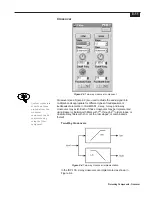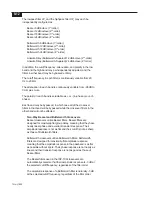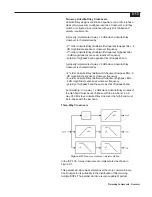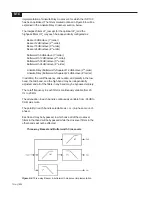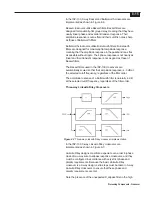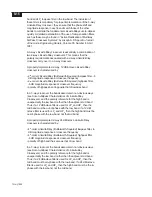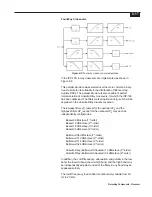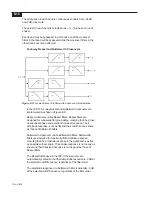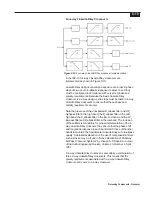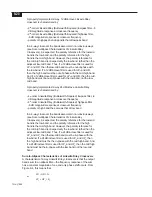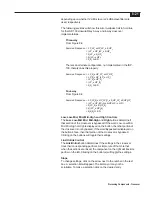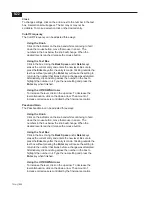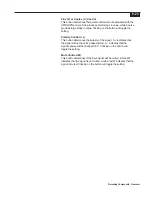
8-8
10 July 1998
input signal was going to be, then the Crest Factor Sensitivity
control would ideally be set to:
Signal
Input
of
Factor
Crest
1
Since this quantity is not generally known, it is best to
experiment until satisfactory results are obtained.
Metering
The compressor meter shows the attenuation applied to the signal
passing through the compressor at any given moment in time. When
the signal is being compressed the meter indicates negative values
(gain less than 1.0). When the signal is not being compressed the
meter indicates 0 dB (gain of 1.0). Meter values are raw, no
averaging or ballistics are applied.
Notes on Operation of the Compressor
Bypass
Bypassing a compressor causes the signal to pass through
unaltered.
Overshoot
The compressor algorithm used in the ISP-100 allows for a small
amount of overshoot on transients, regardless of the settings of
the Detection Window and Crest Factor Sensitivity controls. The
amount of overshoot is somewhat dependent upon the setting of
the Threshold control; the lower the threshold the greater the
overshoot. This represents normal operation for the compressor.
Computation of Average Level
There are two common methods of computing average signal
level; one is based upon RMS (Root Mean Square) calculations,
and the other is based upon Absolute Value calculations. Each
of these methods produces a slightly different value for signal
level, and the difference depends upon the characteristics of the
signal itself. The ISP-100 compressor uses Absolute Value for
its computation of signal level, so the level reported by the
compressor may differ slightly from the RMS value expected for
a given signal.
Crest Factor Sensitivity and Sinewaves
The peak level of a pure sinewave tone is 1.414 times its
average level. The ISP-100 compressor will therefore apply
approximately 3 dB more compression to a pure sinewave
signal when the Crest Factor Sensitivity is set to 1.00 (peak-
responding) than when it is set to 0.00 (average-responding).
This represents normal operation for the compressor.
Sidechaining
When the sidechain input to an ISP-100 compressor is selected
to be a channel other than its input, the compressor controls
must still be set. The sidechain selects only the channel’s data,
Summary of Contents for Integrated Signal Processor ISP-100
Page 1: ...User s Manual ISP 100 INTEGRATED SIGNAL PROCESSOR...
Page 2: ...THIS PAGE LEFT BLANK INTENTIONALLY...
Page 24: ...2 10 10 July 1998 THIS PAGE LEFT BLANK INTENTIONALLY...
Page 32: ...3 8 10 July 1998 THIS PAGE LEFT BLANK INTENTIONALLY...
Page 48: ...5 6 10 July 1998 THIS PAGE LEFT BLANK INTENTIONALLY...
Page 126: ...A 4 10 July 1998 THIS PAGE LEFT BLANK INTENTIONALLY...
Page 128: ...B 2 10 July 1998 MONDOEQ QMS...
Page 129: ...B 3 Standard QuickMAPs 2X6CMBC QMS...
Page 130: ...B 4 10 July 1998 2X8COMB QMS...
Page 131: ...B 5 Standard QuickMAPs 3X6CMBC QMS...
Page 132: ...B 6 10 July 1998 2X8THRU QMS...
Page 133: ...B 7 Standard QuickMAPs 4CHAN QMS...
Page 134: ...B 8 10 July 1998 4X6CMBC QMS...
Page 135: ...B 9 Standard QuickMAPs 4X6THRU QMS...
Page 136: ...B 10 10 July 1998 3_2W QMS...
Page 137: ...B 11 Standard QuickMAPs 2WAYS QMS...
Page 138: ...B 12 10 July 1998 2_3WAY QMS...
Page 139: ...B 13 Standard QuickMAPs 2_2W_SUB QMS...
Page 140: ...B 14 10 July 1998 2_2W_FR QMS...
Page 141: ...B 15 Standard QuickMAPs 2_2W_2ST QMS...
Page 142: ...B 16 10 July 1998 4_2WAYS QMS...
Page 143: ...B 17 Standard QuickMAPs 4W_2FR QMS...
Page 144: ...B 18 10 July 1998 LCR QMS...
Page 145: ...B 19 Standard QuickMAPs MONO3W QMS...


















